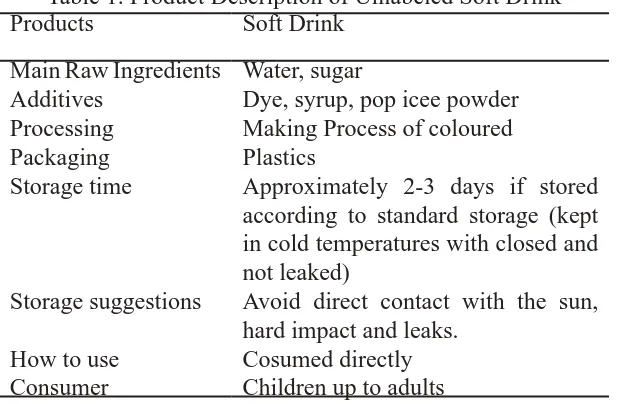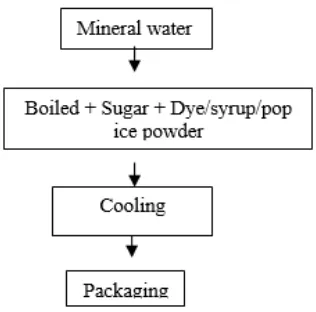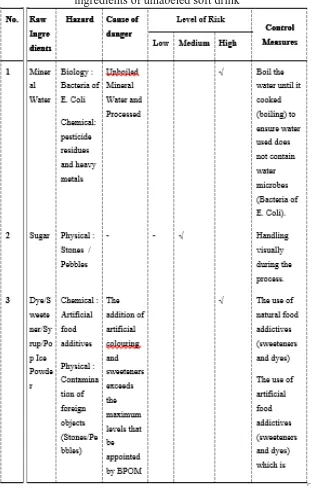Study of Hazard Analysis Critical Control Point (HACCP) On Unlabeled Soft Drink Products Sold by Street Traders In
Banda Aceh
BHAYU GITA BHERNAMA
Prodi Kimia Fakultas Sains dan teknologi Uin Ar-Raniry Banda Aceh
Abstrak : Peredaran minuman ringan tak berlabel yang dijual oleh pedagang kaki lima dalam proses produksi masih diragukan keamanannya sehingga menimbulkan keresahan pada masyarakat. Oleh karena itu, perlu pengetahuan tentang food safety knowladge and practice. Untuk meningkatkan kualitas dan keamanan produk dibutuhkan penerapan HACCP. HACCP menggunakan Panduan Penyusunan Rencana HACCP yang direkomendasikan oleh Standar Nasional Indonesia. Hasil HACCP menunjukan bahwa yang ditetapkan sebagai CCP adalah proses perebusan air mineral, penambahan pewarna/sirup/bubuk pop ice dan pengemasan. Penerapan HACCP yang sesuai akan meningkatkan kualitas dan keamanan produk minuman ringan tak berlabel yang dijual pedagang kaki lima.
Kata kunci : Minuman ringan, HACCP
Abstract : Circulation of unlabeled soft drinks sold by street vendors in process production still questionable safety, causing unrest in society. Therefore, need to be knowledgeable about food safety knowladge and practice. To improve the quality and safety of products required the application of HACCP. HACCP using Plan Preparation Guide of HACCP recommended by the Indonesian National Standard. The results of HACCP showed that the CCP is defined as mineral water boiling process, the addition of a dye / syrup / powder pop ice and packaging proceses. The HACCP application suite will improve the quality and safety of products not labeled soft drinks sold hawkers.
Key word : Soft drink, HACCP
1. INTRODUCTION
The circulation of unsafe soft drink products on the market raises anxiety in the society; so they need more knowledge about food safety knowledge and practice. Therefore, as is food safety knowledge and prectice, there is a possibility for the society to avoid the consumption of dangerous beverages [1]
Hazard Analysis Critical Control Point (HACCP) is a system of control in preventing the occurrence of problems that is based on the identiication of of critical points in the stage of handling and production processes [2]. HACCP is used to prevent the occurrence
of hazards that can be used as a guarantee of food quality in meeting consumer demands. Accordingly, in the presence of HACCP is expected to prevent the risk of complaints because of the dangers in food [3].
The phenomenon of poisoning cases in unlabeled soft drinks that are sold by street vendors has become one of the most serious issues requiring special attention and special handling of the production of soft drinks. The purpose of this research is to know the application of HACCP on unlabeled soft drink products that are sold by street vendors in banda aceh.
2. METHODOLOGY
In the method of the research, samples that will be used as research object are unlabeled soft drinks sold by street vendors. Sampling was done in several places of soft drinks street hawkers in some areas of Banda Aceh. The method of the research used is descriptive research, with the steps as follows;
a. Direct Data Collection (Field Study) ● Interview
The interview conducted directly with the street vendors whom selling unlabeled soft drinks.
● Observation
b. Indirect Data Collection (Literature Study) ● Study Literature
In collecting the data, it was collected by utilizing the data available in books, articles, journals and other sources and relates it to the data obtained from the result of the research in the Laboratory.
● Data Documentation
Once the data is collected, the data were documented and recorded on the data results from the research and implementation of the activity.
● HACCP Planning System
In this stage, it was applied from HACCP principles.
3. DISCUSSION AND RESULT a. HACCP Team Building
The establishment of the HACCP team consists of 3 (three) people, 2(two) persons from the same educational background and 1 (one) person with different educational background. The team directly involved in the ield of observation process. Further, the ield of observation process was established in interviews with street vendors and saw of the production process of soft drinks directly.
b. Product Description
Table 1. Product Description of Unlabeled Soft Drink
Dye, syrup, pop icee powder Making Process of coloured Plastics
Approximately 2-3 days if stored according to standard storage (kept in cold temperatures with closed and not leaked)
Avoid direct contact with the sun, hard impact and leaks.
Cosumed directly Children up to adults
Unlabeled soft drink that sold by street vendors is the own production, which is the products are some kind of coloured soft drinks such as syrup and pop ice.
c. Identiication of User Objectives
This study is aimed to identify how to use soft drink produk by consumen, how to serve and consumen group who cosume the produk [5. In using the unlabeled soft drink produks as the thirst
release that can be cosumed by children up to adult. Unlabeled soft drink can be directly cosumed after the production process is inished.
d. Diagram of Flow Product
Figure 1. Making Process of Unlabeled Soft Drink
Figure 1 is a low diagram of the production process of unlabeled soft drinks. Flow diagram of making process of unlabeled soft drink is important to determine the control stage in eliminate or reduce the occurrence of hazards and also facilitate for monitoring during the production process.
e. HACCP Application of Principles ● Hazard Analysis
Hazard analysis aims to identify hazards that may occur in the production process and the prevention that needs to be done in controlling the hazards [6]. In hazard analysis, this is done to
identify hazard characteristics, so that signiicant or high-risk hazards should be considered in determining a critical control point.
The types of hazards present in unlabeled soft drink products include physical, chemical and biological hazards. Physical hazards include broken glass, canned pieces, stones / pebbles, twigs of wood, hair, nails and others. Chemical hazards include non-food additives, pesticide residues, heavy metals, and allergen materials. Biological hazards include the presence of bacteria, microbes and viruses. These hazards can cause various health problems in humans [7] (Murdiati, 2004).
3 below:
metals and safe for consumption.
f. Boundary Determination of Critical Control Point (CCP) Furthermore, any signiicant hazards should be deined whether it is Critical Control Point (CCP) or not. Critical Control Point (CCP) is a point, step or procedure where the controls can be applied and food hazards can be prevented, eliminated or minimized to acceptable limits. If this stage is uncontrollable it can cause a food safety hazard [8].
Based on the results of decision tree analysis for raw ingredients, it is known mineral water, sugar, dye / syrup / sweetener is not a Critical Control Point (CCP). The three of raw ingredients have signiicant hazards potential; however the next processing stage is considered capable of eliminating or reducing the amount of contamination to the required safe amount. In addition, cross-contamination that may occur during processing is also considered capable of being controlled
Although not considered as a Critical Control Point (CCP), raw ingredients need to be controlled and well supervision. The determination of Critical Control Point (CCP) on raw ingredients can be seen in table 4 below:
Table 4. The determination of Critical Control Point (CCP) on raw ingredients
No Raw Ingredients P1 P2 Informaion
1. Mineral Water Yes Yes Not a CCP
2, Sugar No Yes Not a CCP
3. Dye/syrup/Pop ice powder Yes Yes Not a CCP
of fruit juice that produces natural dyes. The determination of the Critical Control Point (CCP) on the making process of unlabeled soft drink products can be seen in table 5.
CCP can be identiied using knowledge of the production process and all potential hazards and hazard signiication of analysis as well as speciied preventive measures. In addition to help located the correct Critical Control Point (CCP) and should be use in the CCP Decision Tree. The decision tree chart is a logical question series that asks every danger [8]. The answers of each
questions will facilitate and bring the HACCP Team to logically decide whether it is CCP or not. In the other hand to the decision tree chart for the processing, in addition to help establishc it can also be used CCP Decision Tree for raw ingredients and production processes [8].
Tabel 5. The Determination of Critical Control Point (CCP) in the Production Process of Unlabeled Soft Drink
No Processing Stage
P1 P2 P3 P4 Informaion
1 Boiling
In the determination of Critical Control Point (CCP) in table 5 it can be seen there are four critical points contained in the processing unlabeled soft drink products. The four of Critical Control Point (CCP) include boiling mineral water, adding dye / syrup / pop ice powder and packaging.
Further, at the boiling step of the mineral water hazard identiied that there is still water contaminated with E. coli bacteria, heavy metals and pesticide residues. Bacteria of E. coli, heavy metals and pesticide residues found in the boiling process is caused by the lack of boiling water (not reaching the boiling point) so that bacteria do not die at this stage.
boiling mineral water until boiling (cook) reaches 100oC boiling
point.
The addition of dye / syrup / pop ice powder is used by street vendors so that the products sold able to attract the attention of consumers. However, the addition of dye / syrup / pop ice powder will demage the health of consumers, especially the addition of artiicial coloring. The addition of artiicial dyes has a high risk because of the addition of excessive artiicial colouring is not in accordance with government regulations and the use of artiicial colourings that are not allowed. The control measures are conducted with the addition of natural dyes derived from fruits and vegetables. The use of added dyes should be permitted by the government.
Packing process that is unclean causing contamination of foreign objects and the presence of bacteria. This packaging process has medium risk (medium). The proceeding should be performed by cleaning (sterilize) the equipment which used in the packaging process irst.
g. Determination of Monitoring Procedures ( Monitoring )
4. CONCLUSION
REFERENCE
[1.] Gunawan W, Popy A. 2007. Evaluasi bahaya dan penetapan titik kendali kritis pada pembuatan makanan jajanan yang dijual dikawasan wisata Baturaden Purwokerto. Jurnal Pembangunan Pedesaan. 7(3):156 – 164
[2.] Diki Nanang S, Riyanti Eka F. 2014. Kajian HACCP (Hazard Analysis and Critical Control Point) pengolahan jambu biji di Pilot Plant sari buah UPT. B2PTTG-LIPI Subang. Agritech. 34(2) : 266 – 276
[3.] Nuryani A. 2006. Pengendalian mutu penanganan udang beku dengan konsep HACCP. Tesis. Pasca Sarjana Magister Managemen Universitas Diponegoro, Semarang.
[4.] Iffa Z, Sudarmaji. 2008. Hazard Analysis and Critical Control Point (HACCP) pada pengelolaan pasien rawat inap di Rumah Sakit Islam Lumajang. Jurnal Kesehatan Lingkungan. 4(2):57 – 68.
[5.] Aminuddin F, Arif R, lely R. 2013. Desain sistem keamanan pangan Hazard Analysis and Critical Control Point (HACCP) pada proses produksi gula PG.Kebun Agung Malang. Jurnal Rekayasa Manajemen Sistem Industri. 2(6) : 1168 – 1179. [6.] Widyana L. P, Yenny P, Fatma Z. 2010. Penerapan HACCP
terhadap penurunan bahaya mikrobiologis pada makanan khusus anak berbasis hewani di rumah sakit umum daerah Dr. Soedarso Pontianak. Jurnal Gizi Klinik. 7(1):8-16 [7.] Murdiati A, Priadi S, Rachmawati Y. 2004. Susu pasteurisasi
dan penerapan HACCP. JITV. 9(3):172 – 180.
[8.] Sutrisno K. 2009. HACCP dan penerapannya pada produk bakeri. eBook Pangan.




